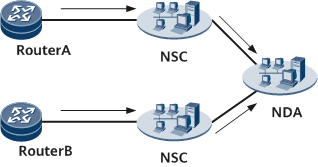Basic Functions of NetStream
As the Internet develops rapidly, more bandwidth resources are provided for users, and at the same time a higher requirement for delicate network monitoring and management is raised. To address this issue, NetStream has been introduced. NetStream is a technique that collects highly granular per-flow traffic statistics. It classifies traffic flow statistics and calculates resource usage on networks. NetStream also helps monitor and manage networks based on the types of services and resources.
Application Scenarios for NetStream
-
NetStream provides detailed accounting statistics, including IP addresses, number of packets, number of bytes, time, type of service (ToS), and application types. Based on the collected statistics, the Internet service provider (ISP) can charge users flexibly based on resource information, such as time periods, bandwidth, applications, or service quality, and enterprises can estimate their expenses and assign costs to efficiently use resources.
-
NetStream provides key information for advanced network management tools to optimize the network design and plan. This helps achieve the best network performance and reliability with the lowest network operation cost.
-
NetStream monitors network traffic in real time.
Application monitoring and analysis
NetStream provides detailed network application information. For example, it allows a network administrator to view the proportion of each application, such as web, the File Transfer Protocol (FTP), Telnet, and other TCP/IP applications, to communication traffic. Based on the information, the Internet Content Provider (ICP) and ISP can properly plan and allocate network application resources.
-
By analyzing NetStream flows, the NMS can detect abnormal traffic, such as different types of attacks on networks in real time. The NMS uses alarm information reported by NetStream to monitor devices to secure network operation.
Operation Process of NetStream
Figure 1 shows the operation process of NetStream, which consists of the following phases:
- Samples flows in a specified mode.
- Establishes NetStream flows based on 5-tuple information.
- Ages out NetStream flows in a specified mode.
- Exports NetStream flows based on the specified mode and packet version.

NetStream Data Exporter (NDE): samples packets and outputs traffic statistics.
NetStream Collector (NSC): collects and stores traffic statistics sent by the NDE.
NetStream Data Analyzer (NDA): analyzes traffic statistics. The analysis result is used as the reference for various functions, such as network accounting, network planning, network monitoring, application monitoring, and traffic analysis.
The NetEngine 8000 F supports the NDE function.
The NetEngine 8000 F supports the distributed NetStream service processing mode. That is, an interface board can independently sample packets, aggregate flows, and output flows. The NetEngine 8000 F supports complete NetStream functions.
